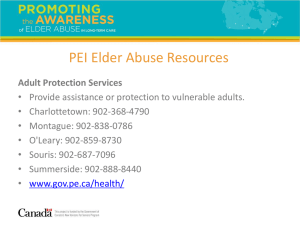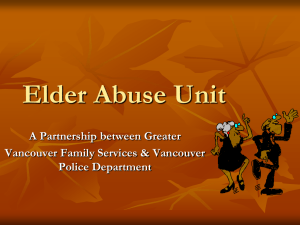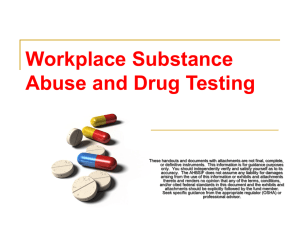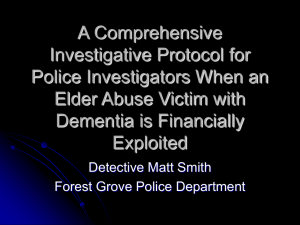Increasing Pharmacist Awareness of Elder Abuse And The Law
advertisement
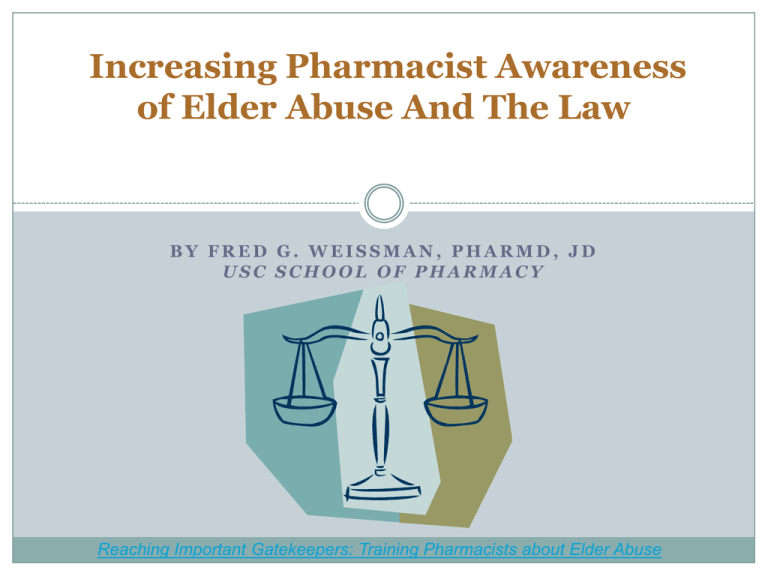
Increasing Pharmacist Awareness of Elder Abuse And The Law BY FRED G. WEISSMAN, PHARMD, JD USC SCHOOL OF PHARMACY Reaching Important Gatekeepers: Training Pharmacists about Elder Abuse Legal References 2 W&I Code = Welfare and Institutions Code PC = Penal (Criminal) Code B&P Code = Business and Professions Code CalApp = California Court of Appeal Background 3 California law recognizes an elderly person to be one who is 65 years or older (CA PC, Sec. 3 68[g][3]) California law also recognizes the vulnerability of the population of “dependent adults” (i.e., adults 18-64 years with a disability) In the 1980s the California Legislature recognized the need to put into effect laws that protect the elderly and establish criminal penalties for offenses against the elderly and adults with disabilities. Nature of Elder Abuse 4 The law provides some general descriptions of what the nature of elder abuse can be: “physical abuse, neglect, financial abuse, abandonment, isolation, abduction, or other treatment with resulting physical harm or pain or mental suffering, the deprivation by a care custodian of goods or services that are necessary to avoid physical harm or mental suffering.” (CA W&I Code, Sec. 15610.07) Mandated Reporters 5 The purpose of these laws is to “require health practitioners, care custodians, clergy members, and local law enforcement agencies to report known or suspected cases of elderly abuse and to encourage community members in general to do so.” (CA W&I Code, Sec. 15601) Further, California Codes have been placed in effect that have a mandatory reporting requirement where noted cases of elderly abuse have occurred. (CA W&I Code, Sec. 15630) Does the Pharmacist Have a Responsibility of Reporting Elder Abuse Cases? 6 CA WIC does not specifically name the licensed or practicing pharmacist as having a mandatory duty to report suspected or noted cases of elderly abuse. However, California Law does state that an reporting obligation exists for health care practitioners (CA WIC, Sec. 15601), and the profession of pharmacy is recognized in the law and that “pharmacy practice is a dynamic patient-oriented health service…” (CA B&P Code, Sec. 4050[a][b]). Therefore, even though there is no case law that tests whether or not a pharmacist would be obligated under the law to make the reporting of suspected or known elderly abuse to the proper authorities, it could be argued that given health care professional status, such reporting would be required. From Request for Renewal of California Pharmacist License Under California law each person licensed by the Board of Pharmacy is a “mandated reporter” for both child and elder abuse or neglect purposes. What does this mean? Examples where a pharmacist might have a responsibility to report 8 Where an elderly patient comes into the pharmacy and complains to the pharmacist that they are being physically being mistreated by a caregiver or a relative. Where an elderly patient comes into the pharmacy and is noted to have physical markings on exposed parts of the body of an unusual nature that may suggest they are not being cared for properly or a party caring for them has possibly caused those physical markings. Where an elderly patient is being deprived of receiving their newly ordered or routine medications. Examples where a pharmacist might have a responsibility to report 9 Where an elderly patient, although receiving their prescription drugs, is not being given the medications by their caregivers. Where an elderly patient assigned to a skilled nursing facility, board and care facility, a hospice care facility, or other similar patient care facility, and is noted by the pharmacist upon his or her visitation to the facility to check on medication control in the facility, to see a case of known or suspected elder abuse. In health care facilities, claims of abuse arise more from omissions rather than commissions 10 These claims may include a failure to employ adequate staffing levels, a failure to develop a plan of care, a failure to accurately maintain medical records, a failure to obtain informed consent, a failure to properly administer medications, a failure to monitor intake and output of fluids, a failure to care for the patient’s hygiene, and a failure to reduce the incidence of incontinence and bedsores. Mandated Reporter Instructions 11 Under California law each person licensed by the Board of Pharmacy is a “mandated reporter” for both child and elder abuse or neglect purposes. CA PC 11166 and W&I Code sec.15630 require that all mandated reporters make a report to an agency specified in PC 11165.9 and W&I Code 15630(b(1) [generally law enforcement, state, and/or county adult protective services agencies, etc…] whenever the mandated reporter, in his or her professional capacity or within the scope of his or her employment, has knowledge of or observes a child, elder and/or dependent adult whom the mandated reporter knows or reasonably suspects has been the victim of child abuse or elder abuse or neglect. How to Report 12 The mandated reporter must contact by telephone immediately or as soon as possible, to make a report to the appropriate agency(ies) or as soon as is practicably possible. The mandated reporter must prepare and send a written report thereof within two working days or 36 hours of receiving the information concerning the incident. Failure to Report 13 Failure to comply with the requirements of CA PC sec. 11166 and W&I Code sec.15630 is a misdemeanor. Penalties Up to six months in a county jail, A fine of one thousand dollars ($1,000), or Both imprisonment and fine How to Report Elder Abuse In the community: Adult Protective Services Social workers/nurses Receive reports of abuse from mandated reporters and others Work with elder/dependent adult to help them access resources in community to stay safe In many states: Cross report to police In residential facilities: Long-term Care Ombudsman Social workers/volunteers Receive complaints from residents Advocate on behalf of residents Work with State Licensing to identify problems in facilities Proving a case of elder abuse 15 The Prosecutor must prove: That the suspect willfully or negligently either a) personally subjected an elder or dependent adult to unjustifiable physical pain or mental suffering or b) allowed another person to do so. That the suspect’s conduct occurred under circumstances that were likely to produce great bodily injury or death, and That the suspect knew or reasonably should have known that the alleged victim was an elder or dependent adult Case Example 16 People v. Manis [10 Cal.App4th 110, 114, 1992] – Case of Criminal Negligence which is more than ordinary carelessness or a mistake in judgment. In this case a 79 year old mother living with her daughter. Over a two week period the daughter failed to feed, clean, or move her mother, leaving her literally to rot away. The daughter was convicted of a felony under Penal Code 368 because her conduct was criminally negligent. It is important to note that an act of criminal negligence exists when the wrongdoer has a legal duty to act. Elder Abuse as a Misdemeanor 17 Misdemeanor Elder Abuse (CA PC, Sec. 368) Informal probation, A maximum on-year county jail sentence, A maximum fine of $6,000 (or $10,000 for a second or subsequent offense), Restitution to the victim, and Counseling Elder Abuse as a Felony 18 Felony elder abuse (CA PC, Sec. 368) Formal probation Two to four years in the California State Prison (with an additional and consecutive three to seven year sentence if the victim suffers great bodily injury or death) Up to $10,000 in fines Restitution, and Counseling. Post-test Questions 19 1) California law recognizes which of the following populations as covered under “elder abuse” protections? A) 60+ B) Age 65+ C) Age 18+ with a disability D) A & C E) B & C 2) HIPAA prevents pharmacists from reporting suspected abuse or neglect if the patient does not give permission for it to be reported. T or F? 3) Suspected elder abuse in the community should be reported to ___________. 4) Failure to report suspected elder abuse and neglect is a misdemeanor. T or F?
